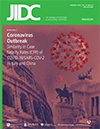Micro-elimination of HCV as a possible therapeutic strategy: our experience and a review of literature
DOI:
https://doi.org/10.3855/jidc.11785Keywords:
hepatitis C infection, micro-elimination, SerbiaAbstract
Background: Serbia has an intermediate estimated prevalence of chronic hepatitis C (CHC) infection, approximately 1.13%, with hepatitis C remaining one of the leading causes of liver-related morbidity and mortality in Serbia with impaired quality of life and overwhelming cost of treating its complications As the availability of new treatment options and resources for screening remains limited, micro-elimination of CHC becomes a top priority.
Methods: Review of the available published data related to the clinical and epidemiological situation of the hepatitis C infection in Serbia, including the unpublished data from the databases of four major reference centres in Serbia (Clinical Center Serbia, Clinical Center Niš, Clinical Center Vojvodina and Clinical Center Kragujevac).
Results: Currently in Serbia, micro-elimination appears to be realistic in the patients with haemophilia, who represent a small, well-defined subpopulation, under constant monitoring by the healthcare system. Other feasible targets for micro-elimination of CHC infection in Serbia are patients on hemodialysis, prisoners and people who inject drugs.
Conclusions: Micro-elimination is feasible in Serbia, especially in the subpopulation of patients with haemophilia. This may represent an initial step towards achieving the WHO objective to eliminate hepatitis C infection by 2030.
Downloads
Published
How to Cite
Issue
Section
License
Authors who publish with this journal agree to the following terms:
- Authors retain copyright and grant the journal right of first publication with the work simultaneously licensed under a Creative Commons Attribution License that allows others to share the work with an acknowledgement of the work's authorship and initial publication in this journal.
- Authors are able to enter into separate, additional contractual arrangements for the non-exclusive distribution of the journal's published version of the work (e.g., post it to an institutional repository or publish it in a book), with an acknowledgement of its initial publication in this journal.
- Authors are permitted and encouraged to post their work online (e.g., in institutional repositories or on their website) prior to and during the submission process, as it can lead to productive exchanges, as well as earlier and greater citation of published work (See The Effect of Open Access).








